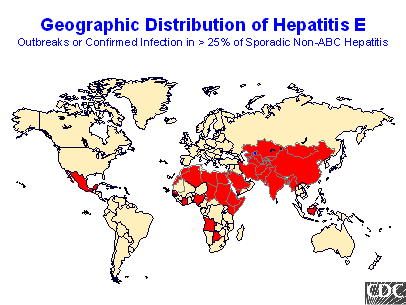Hepatitis E
Organism, Causative Agent, or Etiologic Agent
Hepatitis E is a viral disease that causes inflammation of the liver. Hepatitis E virus (HEV) does not cause chronic disease. In the United States, HEV is rarely found. Mortality (death rate) of those infected with hepatitis E is 1-2%. In pregnant women, the percentage is about 20%.
Hepatitis E virus (HEV) is the only member of the genus Hepevirus in the family Hepeviridae. It is a single-stranded, positive-sense RNA virus. Four genotypes of HEV-infecting mammals are currently recognized. The host range includes pigs, sheep, deer, rabbits, and humans. Other mammals including dogs, cats, and rodents may be hosts.
The CDC slide below illustrates where HEV is present around the world:

© Slide compliments of the Centers for Disease Control's (CDC) presentation entitled: Epidemiology and Prevention of Viral Hepatitis A to E: An Overview.
General Information and Resources
Mailing Address
Disease Surveillance and Epidemiology Section
Mail Code: 3082
P.O. Box 149347
Austin, TX 78714-9347
United States
Physical Address
Disease Surveillance and Epidemiology Section
Moreton Building, Suite M-631
1100 West 49th Street
Austin, TX 78756-3199
United States
